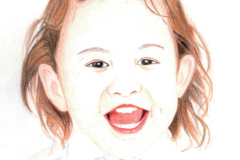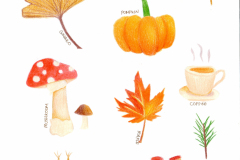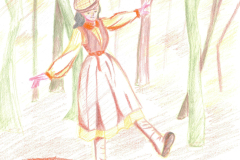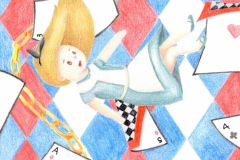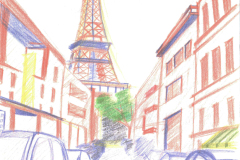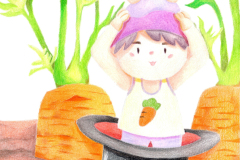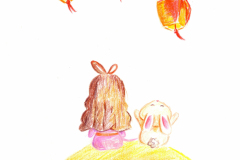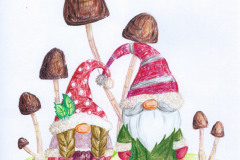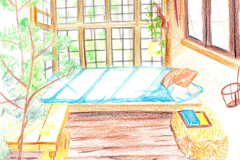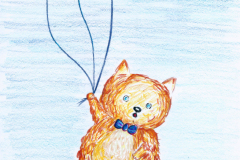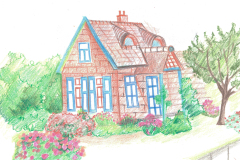Introduction
Capturing the allure of a witchy woman in color pencil portraits invites you to explore a blend of mystique, charm, and artistry. This unique subject offers an exciting challenge that blends cultural symbolism with artistic technique. Portraits featuring witchy women invite viewers to experience a story, a mood, and a personality through every stroke of color pencil.
In this article, you’ll learn practical ways to depict the essence of a witchy woman using color pencils. The journey covers understanding their cultural significance and mastering the artistic skills needed to bring these intriguing characters to life on paper.
Understanding the Witchy Woman Archetype
The witchy woman is a figure shaped by a mix of traits—strength, mystery, intuition, and a touch of rebellion. She’s not just a character from old stories but a symbol that shows up again and again in both culture and art. You might picture her as someone who is deeply connected to nature, a keeper of secret knowledge, or an outsider who challenges social norms.
Some qualities often linked with witchy women include:
- Intuition that feels almost supernatural
- An independent spirit unwilling to conform
- A connection to the natural world and cycles
- Ambiguity between good and bad—she’s neither wholly villain nor saint
- A blend of wisdom and otherworldliness
These traits make her complex and often misunderstood. In art, she becomes a canvas for exploring themes of power, mystery, and transformation.
Cultural Background of Witchy Women
The witchy woman figure has roots that travel through time and geography, shifting shapes as cultures evolve. Historically, she’s been feared and revered—sometimes hunted as a threat, other times consulted for her insight. This duality plays out across centuries, from the witch trials in Europe to the wise women of indigenous tribes.
Her image often reflects societal anxieties about control and gender. Mostly, she’s a woman who steps outside accepted roles, which can be threatening or inspiring depending on perspective.
In today’s culture, the witchy woman is sometimes reclaimed as a symbol of empowerment—a way to challenge old stigmas tied to fear or superstition. She carries traces of past struggles but also new meanings, shaped by feminist and spiritual movements.
Why Witchy Women Inspire Artists
Artists find witchy women endlessly fascinating because they embody complexity and mystery—qualities that invite exploration. There’s something magnetic about portraying a figure who seems to hold secrets, who isn’t fully revealed in a single glance. This allows artists to play with light and shadow, subtle expressions, and symbolism.
The witchy woman also challenges artists to capture more than physical likeness—to suggest an inner world or aura. You might notice how artists use unexpected colors or textures to hint at her energy or presence.
Plus, the cultural weight behind her image adds layers to the artwork. She offers a chance to question ideas about power, femininity, and identity. Maybe that’s why witchy women keep turning up in portraits—they never feel quite finished, always inviting new interpretations.
Choosing the Right Materials for Color Pencil Portraits
Selecting Color Pencils
When working on a color pencil portrait of a witchy woman, the choice of pencils shapes much of your final effect. You’ll want pencils that offer both smoothness and precision. Wax-based pencils, like Prismacolor Premier, are popular because they blend well and build rich layers. Yet, some artists prefer oil-based pencils such as Faber-Castell Polychromos for their harder lead and finer detail. Each type feels different in your hand and responds uniquely on paper. You might even experiment with both to capture the depth and texture of witchy skin, fabrics, or jewelry.
The key is layering—thin layers stack to create shadows, highlights, and the eerie glow or shadowy allure witchy portraits demand. If your pencils are too soft, you risk wax bloom, which dulls the finish after a time. On the flip side, harder pencils can scratch the paper, which could add texture—sometimes intentionally, sometimes not. So, there’s a bit of trial and error involved in finding your perfect balance.
Paper Choices Matter
Paper choice plays a bigger role than many expect. Smooth Bristol paper offers a clean surface for sharp details, ideal if your witchy woman has delicate facial features or crisp accessories like silver pendants. Yet, that same smoothness can work against you when layering many colors—it can limit how much pigment the paper holds.
Textured papers, like cold-pressed watercolor paper or toned sketch pads, absorb more pigment and lend a subtle grain to your work. This grain can add a bit of mystery, a tactile quality that suits the otherworldly vibe of a witchy portrait. But too much texture might make detailing small features trickier—you may find edges softer or lines less defined.
Personally, I found that using a mid-weight, slightly textured paper strikes a reasonable compromise. It allows good layering without losing fine details. You might want to test a few samples—scratch the surface with your pencil, blend a little, and see which gives that elusive witchy aura without fighting your technique.
Planning Your Witchy Woman Portrait Composition
Sketching the Base
Starting your portrait means building a strong foundation. Focus first on the expression—witchy women often carry something intense or mysterious in their gaze. You might want eyes half-closed, almost like they’re caught between worlds, or wide and piercing, as if they see things others don’t. The pose matters, too; a slight tilt of the head or a relaxed yet confident posture can convey a lot. Sometimes I find it tricky to settle on one pose, but don’t rush—experiment with rough sketches to find what feels right.
Keep your lines light and loose at this stage. Capturing the mood early on will help when you move to details. Don’t stress about proportions being perfect, but get a sense of balance and flow. Often, the way the shoulders slant or the neck curves adds more to the character than just the face alone.
Highlighting Witchy Elements
Once the base is set, think about what features make your subject unmistakably witchy. Mystical eyes? Maybe add an unusual eye shape or subtle glimmer—either hinting at magic or hidden knowledge. Clothing can speak volumes too. Flowing robes, lace collars, or elements that suggest old-world charm work well. Accessories like amulets, rings with strange stones, or even a slightly crooked hat can add layers to the persona.
Don’t feel confined by typical symbols. Maybe your witch wears a modern jacket but has a pendant shaped like a crescent moon. Or her hair is wild yet tangled with herbs or feathers. These little choices pull the viewer in and keep the portrait from feeling cliché. I often find that combining classical and unexpected elements leads to the most interesting portraits—what will you try?
Techniques for Shading and Texture in Color Pencil
Shading plays a crucial role when bringing your witchy woman portrait to life, giving it depth and a sense of realism. Start by observing the light source carefully—this will guide where shadows fall and where highlights need to shine. Don’t rush layering; build your shading gradually using a light hand, which helps in blending and avoiding harsh lines. Try circular strokes for smoother gradients or soft back-and-forth motions for a more textured effect, especially on the skin.
Layering colors takes patience but pays off. Begin with light tones and slowly overlay darker shades to enrich the hues. It’s almost like mixing paint, but more controlled. For instance, you might layer blues, purples, and even a touch of red to capture the subtle undertones in shadowed skin. Sometimes I find that throwing in unexpected colors—like faint greens or oranges—can surprise you by adding natural vibrancy.
When tackling texture, focus first on the hair. Use quick, sharp strokes to mimic strands, but vary the pressure for volume. For skin, smooth shading with light layers works best, while a gentle touch with a blending stump or tissue softens the effect without losing pencil detail. Clothing, especially mystical or flowing fabrics, is where creativity helps—you might use cross-hatching or stippling to suggest different materials like lace, velvet, or sheer cloth. Experiment with these, and don’t be afraid if some areas feel rough or inconsistent; imperfections sometimes make the portrait more compelling.
Capturing Expression and Emotion
When you set out to draw a witchy woman, the face must tell a story beyond just looks. It’s not enough to sketch features; you want those features to carry an air of mystique, to pull the viewer in like a whisper caught on the wind. The eyes play a huge role here—they need to captivate, almost trap your gaze. Rather than making the eyes overly detailed or sparkling, try to convey a mix of emotions: curiosity, secrecy, and something—well—untouchable.
Focus on the shape of the eyes and the subtle shadows around them. The eyelids could be slightly lowered or quirked up; either way, avoid a straightforward stare. Suggest complexity through a slight narrowing or perhaps a subtle asymmetry where one brow lifts just a bit. Such tiny irregularities make a face feel alive, or in this case, enchantingly elusive.
For facial expressions, think about elusive smiles or gentle furrowing of the brow—an almost unreadable look. There’s a certain charm in withholding too much, creating intrigue by what remains unspoken in the expression. Which muscles tighten, which relax? Use your pencil to capture these small details, layering light and shadow to hint at emotion without declaring it outright. It’s a dance, really—between revealing and hiding.
Incorporating Symbolic Elements in Your Portrait
When you bring a witchy woman to life in colored pencil, small details can make a huge difference. Adding symbolic objects or background elements connects the portrait to witchcraft and mystery in subtle but powerful ways. These choices don’t just decorate—they tell a story.
Mystical Symbols and Accessories
Some symbols pop up often with witchy themes, and capturing them right can feel tricky at first. Think about including:
- Pentacles or pentagrams: Draw them with careful lines, but don’t obsess over perfect geometry. Slight irregularities can actually feel more natural, like hand-drawn markings.
- Herbs and plants: Sage bundles, lavender sprigs, or black roses give texture and hint at rituals. Study reference photos to get leaf shapes and grain patterns just right.
- Jewelry: Moon-shaped earrings, crystal pendants, or rings with mysterious stones—add highlights to capture their glint without making them overpower the face.
- Books and scrolls: Old, worn covers with faint runes or symbols suggest secret knowledge. Rough edges and texture play well with pencil techniques.
- Tarot cards or crystals: The shapes don’t have to be rigid—loosely defined cards or faceted stones can create mystery without clashing with realism.
Each item can feel like a clue or a whisper from another world. Drawing them carefully, with just enough detail, invites the viewer to look closer without overwhelming the portrait.
Background Choices
Choosing the right background colors and forms can lift the witchy vibe beyond just the figure. Dark, moody tones—deep purples, dark blues, smoky grays—often work well. They contrast with pale skin or vibrant eyes, making features pop.
Shapes in the background can suggest energy or ritual spaces. Soft, swirling lines might hint at smoke or magic in motion. Geometric shapes like circles or triangles subtly mirror the symbols in the foreground. A flat, almost abstract background can help the subject feel timeless, untouched by the usual world.
Sometimes, a simple gradient works just fine—fading from dark to light gives depth without stealing attention. I’ve found that experimenting with these options can lead to unexpected results, some that don’t seem to “fit” at first but then transform the portrait’s mood entirely.
Finalizing and Preserving Your Color Pencil Portrait
Adding Highlights and Details
After laying down the main colors and shadows, the final highlights really bring your portrait to life. Using a white or very light pencil, gently add bright spots on the eyes, lips, or where light naturally hits the skin. Sometimes just a few small strokes can make the portrait pop, giving it that subtle glow or wetness that feels almost alive.
But be careful not to overdo it; too many highlights might flatten the image or distract from the overall mood. I’ve found that testing on a scrap piece helps—try different pressures and see how the paper reacts. You might want to sharpen your pencils extra fine for these touches, so details remain crisp.
Protecting Your Artwork
Once you’re happy with your piece, sealing it can preserve the delicate layers of color. Fixatives designed for colored pencils protect against smudging but can sometimes change the look, making colors dull. It’s a bit of a gamble—spray lightly and from a distance, maybe even trying on a test sheet first.
Storing your portrait properly also matters. Keep it inside a portfolio or cover it with clean, acid-free paper to avoid dust and fading. Avoid direct sunlight or humid places. Sometimes I store finished drawings between sheets of glassine paper—it’s thin but protective.
Does your workspace get dusty? Sometimes just covering the art with a clear plastic sleeve helps without any chemical fixatives. You might try different methods and settle on whatever feels right for you and your style. The key is balancing preservation with keeping that fresh, hand-drawn charm intact.
Drawing Inspiration and Next Steps
When it comes to finding that spark for your witchy woman portraits, inspiration can come from quite unexpected places. You might start with folklore or mythology books — they offer a rich tapestry of characters and symbols that feel timeless, even if they’re a bit tangled or contradictory. Sometimes I find myself drawn to old films or even vintage photography, where the gaze of the subject holds a certain quiet power that can be hard to replicate from imagination alone.
Online art communities can also be a treasure trove. Looking at how other artists interpret witchy themes with color pencils might challenge your ideas but also open doors to new techniques. Don’t hesitate to collect references from nature too — like the way light filters through branches or the subtle tones in autumn leaves. These details can bring authenticity to your portraits without getting lost in clichés.
As you continue, think about expanding your practice beyond portraiture. Maybe experiment with mixed media or try capturing other mystical subjects. The key is to keep exploring without feeling locked into one style or motif. Your witchy woman might evolve, or maybe you’ll discover other intriguing characters in your art along the way. What matters most is keeping your curiosity alive — it’s almost as if the art chooses you just as much as you choose it.
Conclusions
Exploring the world of witchy women in color pencil portraits reveals the power of art to convey stories and emotions. By combining cultural insights with focused artistic skills, you open new paths for your creativity. Each portrait becomes more than an image; it tells a story that attracts and holds attention.
Whether you are inspired by symbolism, technique, or both, these portraits of witchy women offer you a rich canvas to express your ideas. Use the tips and insights shared here to start your own journey and create portraits that captivate and intrigue.


















